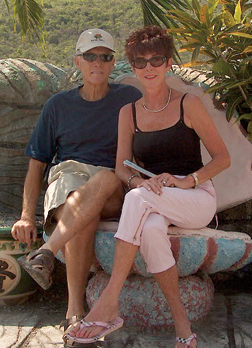 |
Tom and Bev Evans in Vietnam in 2005. |
“Things are not always what they seem,” Evans cautions. “When you do your patient exams, if you feel the slightest swelling in a lymph node or in the neck, or a change in the throat like hoarseness or a persistent sore throat, do not always consider it to be only a low-grade infection. It could be much worse.”
The retired Golden, Colo., dentist should know. In 2005 he was diagnosed with squamous cell cancer at the base of the tongue. After two large doses of the chemotherapy drug, carboplatin; seven weeks of the drug, cisplatin; and radiation, he is now considered cancer free.
“I am still able to see the sunrise for a few more years,” said a grateful Evans, a 1962 graduate of the UNMC College of Dentistry.
Evans said he had none of the common risk factors for head and neck cancer. He never smoked, except for a few cigars in dental school. He drank only moderately and then usually red wine. He worked out daily his entire life, and he watched his diet. “My risk factors for squamous cell were low,” he said, noting that 10 percent to 15 percent of head and neck cancers occur in patients with no risk factors.
Evans is absolutely right, says Dr. Nagamani Narayana, professor of oral pathology at the UNMC College of Dentistry. People think if they don’t have any risk factors, they won’t get the disease, but that’s not always the case, she said.
The good news, Evans said, is that squamous cell cancer is highly treatable if detected early; the success rate for a three- to five-year cure is 50 percent to 80 percent. The treatment can be tough.
“I had a port placed in my arm for the chemotherapy and a feeding tube in my stomach for nutrition,” he said. He lost more than 10 pounds on his already trim frame. Had he still been practicing dentistry – he retired in 1999 – he wouldn’t have been able to work for many months because of the rigorous treatment and recovery, he said.
Now, he and his wife, Bev, have resumed their world travels. They traveled to Zambia in June with College of Dentistry classmate Cork Rowley and his wife, who live in Longmont, Colo. The Evanses traveled to Indonesia and Vietnam last year, shortly after his recovery.
While Evans has recovered much of his sense of taste, the radiation treatments wiped out his salivary function and left him with dry mouth. To compensate, he drinks water constantly.
Evans first went to the hospital emergency room in the fall of 2004 because of a pain in his neck and his inability to move his head up, down, or sideways. He and his wife had recently returned from India, where he had developed an upper respiratory infection. “I was given antibiotics, and the neck got immediately better,” he said. “I figured that was the end of it, but it was only the beginning.”
During the emergency room visit, Evans underwent a CT scan. Later, the emergency room doctor sent the scan to a specialist who ordered a biopsy. “I thought I had caught some virus in India. To my shock, he said I had squamous cell cancer cells in the lymph node.” A biopsy on the base of the tongue, tonsillar pillars, nasopharynx, and esophagus revealed squamous cell cancer at the base of the tongue. A PET/CT scan showed a 2-centimeter lesion on the left side.
Out of curiosity, Evans later asked two dental friends, who didn’t know his diagnosis, to examine him to see if they saw anything abnormal. Both “felt around and looked in my mouth and down my throat, and neither could find anything,” Evans said. “The lymph node on the left side under my chin was the only symptom I had.”
Evans said his experience is a lesson for his dental colleagues when they are conducting routine head and neck cancer exams. “Even though you think it is isn’t anything, it could be something. With any little swelling that persists, it may be worthwhile to keep watching it,” he said.